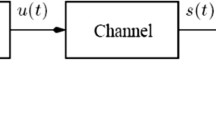Abstract
Orthogonal frequency division multiplexing (OFDM) technique has been widely adopted in many wireless communication systems due to its high data-rate transmission ability and robustness to the multipath fading channel. One of the major drawbacks of OFDM signal is the high peak-to-average power ratio (PAPR). In this paper, a software reference model for OFDM is developed and verified for its functionality that can be adopted for wireless communication applications. Bit error rate (BER) and functionality of the developed OFDM model is analyzed for 16-QAM, 64-QAM, and 256 QAM. We present a technique to reduce the BER of the transmitted signals and hence reduce the PAPR by introducing sequences. We propose a reliable BER reducing method that consists in putting together a Golay sequence with the input sequence. This new method offers competitive performance as well as low BER compared to previously published methods. Computer simulation for a standard OFDM system shows BER reduction by comparison to the competitive methods.





Similar content being viewed by others
References
Karthiga, M., Chitra, P. (2012). PAPR reduction scheme for OFDMA uplink system in WiMAX with different modulation schemes and subcarrier assignments. In International Conference on Communication Systems and Network Technologies (IEEE) 2012, 11–13 May 2012, pp 643–648. ISBN:978-1-4673-1538-8.
Rahmatallah, Y., & Mohan, S. (2013). Peak to average power ratio reduction in OFDM systems: A survey And taxonomy. IEEE Communications Surveys and Tutorials, 15(4), 1567–1592.
Ryu, H.-G., Lee, J.-E., & Park, J.-S. (2004). Dummy sequence insertion (DSI) for PAPR reduction in the OFDM communication system. IEEE Transactions on Consumer Electronics, 50(1), 89–94.
Proakis, J. G. (2001). Digital communications (4th ed.). New York: McGraw-Hill.
Gold, R. (1968). Maximal recursive sequences with 3-valued recursive crosscorrelation functions. IEEE Transactions on Information Theory IT, 14, 154–156.
Huang, S., Wu, H., Chang, S., & Liu, X. (2010). Novel sequence design for low-PMEPR and high-code-rate OFDM systems. IEEE Transactions on Communications, 58(2), 405–410.
Anamul Islam, A. Md., Julkarnain, C. Md., & Abdul Kader, B. Md. (2010). BER performance analysis of a real data communication through WiMAX-PHY layer over an awgn and fading channels. International Journal of Electrical and Computer Sciences, IJECS-IJENS, 10(04), 13–16.
Jubair, G. F. A., Hasan, M. I., & Obaid Ullah, Md. (2009). Performance evaluation of IEEE 802.16e (mobile WiMAX) in OFDM physical layer. Thesis, Blekinge Institute of Technology.
Nee, R. V., & Prasad, R. (2000). OFDM for wireless multimedia communications. Norwood, MA: Artech House Publishers.
Prasad, R. (2004). OFDM for wireless communications systems. Boston: Artech House.
Author information
Authors and Affiliations
Corresponding author
Rights and permissions
About this article
Cite this article
Uppal, S., Sharma, S. & Singh, H. Analysis of BER for M-QAM and QOS Enhancement for OFDM Systems. Wireless Pers Commun 86, 513–520 (2016). https://doi.org/10.1007/s11277-015-2942-9
Published:
Issue Date:
DOI: https://doi.org/10.1007/s11277-015-2942-9




